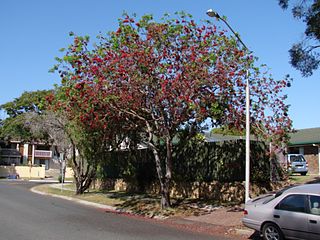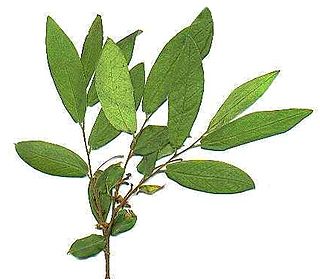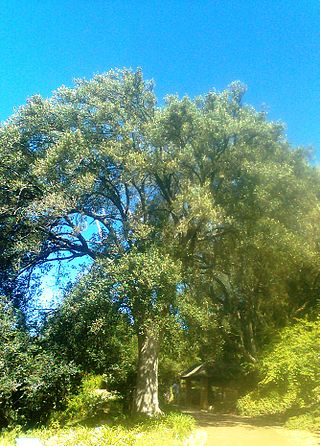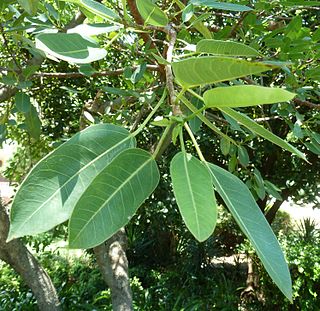
Schotia brachypetala, the weeping boer-bean, is a leguminous flowering tree in the family Fabaceae and the subfamily Detarioideae. The woodland tree is native to Africa south of the Zambezi River, where it occurs at middle altitudes. It is well-suited as shade or ornamental tree in warmer regions, and is consequently widely cultivated in gardens and parks. It is named for the copious nectar that drips from its flowers, which attracts various species of birds and insects. It is known by various other names, including tree fuchsia, African greenheart and African walnut.

Combretum edwardsii, the Natal combretum or forest climbing bushwillow, is an uncommon forest plant endemic to the mistbelt region of eastern South Africa. It has a climbing habit and the stems may often lie prostrate on the forest floor or on cliff tops. As with some other Combretum species the leaves assume autumn colours before they are shed. The plant flowers in spring and the 4-winged fruits reach maturity in late summer.

Combretum padoides, the thicket bushwillow, occurs in the lowlands of tropical and south-eastern Africa. They grow in a range of habitats from muddy riverbanks to dry rocky hillsides. The mostly opposite oval leaves are carried on long slender branches. The trees or shrubs flower in profusion in mid-summer and the 4-winged fruits reach maturity from late summer to mid winter.

Barringtonia racemosa is a tree in the family Lecythidaceae. It is found in coastal swamp forests and on the edges of estuaries in the Indian Ocean, starting at the east coast of Mozambique and KwaZulu-Natal to Madagascar, India, Sri Lanka, Malaysia, Maldives, Thailand, Laos, southern China, northern Australia, coastal Taiwan, the Ryukyu Islands and many Polynesian islands.

Celtis africana, the white stinkwood, is a deciduous tree in the family Cannabaceae. Its habit ranges from a tall tree in forest to a medium-sized tree in bushveld and open country, and a shrub on rocky soil. It occurs in Yemen and over large parts of Africa south of the Sahara. It is a common tree in the south and east of southern Africa, where the odour given off by freshly-cut green timber is similar to that of Ocotea bullata or black stinkwood.

Trichilia dregeana, commonly known as the forest natal-mahogany, is a tree in the family Meliaceae. These trees are found in forest areas from the Eastern Cape of South Africa to Tropical Africa.

Mimusops caffra is a species of tree in family Sapotaceae. This tree is found in coastal dune vegetation in Southern Africa from the Eastern Cape, through KwaZulu-Natal to southern Mozambique.

Kiggelaria africana is a large, robust, low-branching African tree, and is currently the only accepted species in the genus Kiggelaria.

Combretum erythrophyllum, commonly known as the river bushwillow, is a medium to large-sized, spreading tree found in bush along river banks in southern Africa. It is planted as a shade and ornamental tree in South Africa and the United States, and is propagated by seed.

Senegalia ataxacantha, commonly known as the flame thorn, is an African tree species with conspicuous red pods and numerous hooked prickles.

Ficus sur, with the common names Cape fig and broom cluster fig, is a widespread Afrotropical species of cauliflorous fig.

Cryptocarya woodii, the Cape quince, is a shrub or small forest tree, native to southern and eastern Africa. Its Latin name commemorates John Medley Wood, a botanist in Natal. From mid summer the tree bears small, inconspicuous flowers. The ripe fruit have a bumpy surface and are shiny, purple-black in colour. When a leaf is viewed against light some minute secretory glands are visible in the vein polygons (areolae). The larvae of Papilio euphranor and Charaxes xiphares breed on the foliage of this tree.

The Wonderboom is an evergreen fig species that ranges from the KwaZulu-Natal midlands northwards to tropical East Africa. It grows especially on outcrops, rocky hillsides and along cliffs fringing water courses and may rarely grow up to 10 m tall, and acquire a leafy spreading crown.

Ficus ingens, the red-leaved fig, is a fig species with an extensive range in the subtropical to dry tropical regions of Africa and southern Arabia. Despite its specific name, which means "huge", or "vast", it is usually a shrub or tree of modest proportions. It is a fig of variable habit depending on the local climate and substrate, typically a stunted subshrub on elevated rocky ridges, or potentially a large tree on warmer plains and lowlands. In 1829 the missionary Robert Moffat found a rare giant specimen, into which seventeen thatch huts of a native tribe were placed, so as to be out of reach of lions.

Euclea crispa, commonly known as the blue guarri, is an Afrotropical plant species of the family Ebenaceae. The hardy and evergreen plants may form a dense stand of shrubs, or grow to tree size. It is widespread and common in the interior regions of southern Africa, and occurs northward to the tropics. Though some are present near the South African south and east coasts, they generally occur at middle to high altitudes. It is readily recognizable from its much-branched structure and dull bluish foliage colour. Those bearing lanceolate leaves may however resemble the Wild olive, another common species of the interior plateaus.

Dalbergia armata is a scrambling, deciduous species of legume that is native to subtropical to temperate regions of southeastern Africa. The robust, woody liana or small tree is armed with strong spines on the main stem and branches. It occurs sparsely or commonly in forest, bush, riparian fringes and in wooded ravines. It is sometimes employed as a bonsai subject, and it can be propagated from either seed or cuttings.

Protorhus longifolia, the red beech, is a medium to large, mostly dioecious species of tree in the family Anacardiaceae. It is native to South Africa and Eswatini, where it occurs in well-watered situations from coastal elevations to 1,250 m. The leafy, evergreen trees have rounded crowns and usually grow between 6 and 10 m tall, but regularly taller in forest.
Osyris daruma is a species of plant in the family Santalaceae.

Boscia foetida, commonly known as the stink shepherd's tree and the smelly shepherd's bush, is an evergreen shrub or tree that is native to the warmer and drier parts southern Africa. It is found in semi-desert and arid bushveld, and in the west it occurs commonly in areas which are otherwise sparsely wooded. It is known for the particularly unpleasant smell of its flowers which appear during early spring, to which its specific name foetida alludes. Its freshly cut wood likewise has an unpleasant smell, and has traditional medicinal and magical uses, for instance as a protection against lightning. In central Botswana the village of Mopipi is named after this species.

Kalanchoe longiflora, also known as tugela cliff-kalanchoe or long-flower kalanchoe, is a species of the succulent genus Kalanchoe, in the family Crassulaceae. An obscure shrub native to South Africa, it is known for its multi-coloured foliage and yellow flowers, which bloom in autumn to winter.























